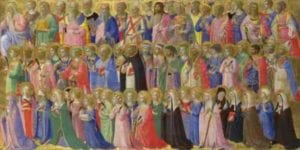
The Communion of Saints
A saint is a holy person. A saint is called to be humble, repent of his sins, grow in virtue and continue the ministry of Christ in the world, as a member of His visible Body, bringing God’s presence, love and mercy to others. Since the 1st century the Church has recognized those Christians whose lives truly reflect the Gospel mission of faithfulness to Christ and love of neighbor. Saints who are officially canonized are held up as role models for living in Christ and whose entrance into heaven after death is certain.
The reason why Catholics have images, statues and stained glass of Saints is to remind us of the heroes of the faith, kind of like keeping photos in a family album or statues of our national heroes. Christ is the visible image of the invisible God, so the members of His Body can be put into images too. A 3rd century catacomb painting was found of Mary holding the baby Jesus.
All Saints day started in the Eastern churches around the 4th century in the month of May to commemorate all the martyrs who have died for bearing witness to Christ. By the year 800, Christians living in England and Ireland started to observe the feast of All Saints on November 1st. The Western Church wanted people to understand that those who died in Christ are still part of our family in God and that they can help us with their prayers. Eventually, the feast of All Saints became official sometime in the 9th century to encourage a correct understanding of the Communion of Saints.
The Communion of Saints is comprised of the Church Triumphant, the Church Militant and the Church Suffering. The Church Triumphant refers to the Saints in heaven, the Church Militant refers to the faithful here on earth, who are engaged in battle against sin and evil, and the Church Suffering refers to the souls in Purgatory, who are undergoing their purification before entering heaven.
The day before on October 31st came to be known as Halloween, which comes from the words “All Hallows Even”, which means the “Evening before All Holies.” In fact, Halloween used to be called “Hallowmass” or “Mass for All Saints”, which is offered in honor of All Saints. In the Middle Ages, Christians would go around from house to house begging for small pastries called “soul cakes”, in exchange for offering prayers for the soul of any deceased.
The Catholic Church decreed through the Council of Trent that all bishops and others who hold the office of teaching the faith, are to instruct the faithful in matters regarding the intercession and invocation of the saints, the veneration of relics, and the legitimate use of images, teaching them that the Saints in heaven offer up their prayers to God for men, and that it is good and beneficial to invoke them and to have recourse to their prayers, assistance and support in order to obtain favors from God, through His Son Jesus Christ our Lord, who alone is our Redeemer and Savior. Furthermore, the honor which is shown to the Saints is referred to the prototypes which they represent, so that by means of the images which we venerate, we adore Christ and venerate the Saints whose likeness they bear.

This year’s Advent Retreat (in Chinese) will be on December 7-8. Fr. Bill has invited Fr. Jianping Li to conduct the retreat. Fr. Li is from the Church of the Transfiguration in Manhattan, New York. The theme of the Advent retreat is “From Nazareth to Bethlehem – Listening to Matthew and Luke about Emmauel.” The Advent retreat consists of three parts: on Saturday, December 7, the morning session is from 10:00 am to 12:00 pm, and the afternoon session is from 2:00 pm to 4:00 pm. On Sunday, December 8, Fr. Li will share a reflection from 12:30 pm to 1:30 pm. All are invited!

The Sacrament of the Anointing of the Sick will be ministered today by Fr. Bill in the chapel after the morning Mass. This sacrament is intended for persons whose health is seriously impaired by illness or old age.
Pastoral council meets today at 12:30 pm. Finance council meets at 1:30 pm.